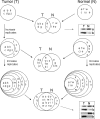Overcoming key technological challenges in using mass spectrometry for mapping cell surfaces in tissues
- PMID: 20548103
- PMCID: PMC3033688
- DOI: 10.1074/mcp.R110.000935
Overcoming key technological challenges in using mass spectrometry for mapping cell surfaces in tissues
Abstract
Plasma membranes form a critical biological interface between the inside of every cell and its external environment. Their roles in multiple key cellular functions make them important drug targets. However the protein composition of plasma membranes in general is poorly defined as the inherent properties of lipid embedded proteins, such as their hydrophobicity, low abundance, poor solubility and resistance to digestion and extraction makes them difficult to isolate, solubilize, and identify on a large scale by traditional mass spectrometry methods. Here we describe some of the significant advances that have occurred over the past ten years to address these challenges including: i) the development of new and improved membrane isolation techniques via either subfractionation or direct labeling and isolation of plasma membranes from cells and tissues; ii) modification of mass spectrometry methods to adapt to the hydrophobic nature of membrane proteins and peptides; iii) improvements to digestion protocols to compensate for the shortage of trypsin cleavage sites in lipid-embedded proteins, particularly multi-spanning proteins, and iv) the development of numerous bioinformatics tools which allow not only the identification and quantification of proteins, but also the prediction of membrane protein topology, membrane post-translational modifications and subcellular localization. This review emphasis the importance and difficulty of defining cells in proper patho- and physiological context to maintain the in vivo reality. We focus on how key technological challenges associated with the isolation and identification of cell surface proteins in tissues using mass spectrometry are being addressed in order to identify and quantify a comprehensive plasma membrane for drug and target discovery efforts.
Figures

Similar articles
-
Tools for phospho- and glycoproteomics of plasma membranes.Amino Acids. 2011 Jul;41(2):223-33. doi: 10.1007/s00726-010-0796-8. Amino Acids. 2011. PMID: 21061027 Review.
-
Mascot file parsing and quantification (MFPaQ), a new software to parse, validate, and quantify proteomics data generated by ICAT and SILAC mass spectrometric analyses: application to the proteomics study of membrane proteins from primary human endothelial cells.Mol Cell Proteomics. 2007 Sep;6(9):1621-37. doi: 10.1074/mcp.T600069-MCP200. Epub 2007 May 28. Mol Cell Proteomics. 2007. PMID: 17533220
-
Advances in the mass spectrometry of membrane proteins: from individual proteins to intact complexes.Annu Rev Biochem. 2011;80:247-71. doi: 10.1146/annurev-biochem-062309-093307. Annu Rev Biochem. 2011. PMID: 21548785 Review.
-
Large-scale identification of membrane proteins based on analysis of trypsin-protected transmembrane segments.J Proteomics. 2016 Oct 21;149:15-22. doi: 10.1016/j.jprot.2016.03.016. Epub 2016 Mar 11. J Proteomics. 2016. PMID: 26975722
-
Membrane protein digestion - comparison of LPI HexaLane with traditional techniques.Methods Mol Biol. 2011;753:129-42. doi: 10.1007/978-1-61779-148-2_9. Methods Mol Biol. 2011. PMID: 21604120
Cited by
-
Proteome and Network Analysis Provides Novel Insights Into Developing and Established Chemotherapy-Induced Peripheral Neuropathy.Front Pharmacol. 2022 Feb 18;13:818690. doi: 10.3389/fphar.2022.818690. eCollection 2022. Front Pharmacol. 2022. PMID: 35250568 Free PMC article.
-
Proximity Labeling of Cell Surface Proteins via Cell Surface Remodeling.Methods Mol Biol. 2025;2908:33-50. doi: 10.1007/978-1-0716-4434-8_3. Methods Mol Biol. 2025. PMID: 40304901
-
A reference map of the membrane proteome of Enterococcus faecalis.Proteomics. 2011 Oct;11(19):3935-41. doi: 10.1002/pmic.201100103. Epub 2011 Aug 31. Proteomics. 2011. PMID: 21800426 Free PMC article.
-
Integrative Temporo-Spatial, Mineralogic, Spectroscopic, and Proteomic Analysis of Postnatal Enamel Development in Teeth with Limited Growth.Front Physiol. 2017 Oct 24;8:793. doi: 10.3389/fphys.2017.00793. eCollection 2017. Front Physiol. 2017. PMID: 29114228 Free PMC article.
-
Proteomic approaches in research of cyanobacterial photosynthesis.Photosynth Res. 2015 Oct;126(1):47-70. doi: 10.1007/s11120-014-0050-4. Epub 2014 Oct 31. Photosynth Res. 2015. PMID: 25359503 Review.
References
-
- Dhillon A. S., Hagan S., Rath O., Kolch W. (2007) MAP kinase signalling pathways in cancer. Oncogene 26, 3279–3290 - PubMed
-
- Lallet-Daher H., Roudbaraki M., Bavencoffe A., Mariot P., Gackière F., Bidaux G., Urbain R., Gosset P., Delcourt P., Fleurisse L., Slomianny C., Dewailly E., Mauroy B., Bonnal J. L., Skryma R., Prevarskaya N. (2009) Intermediate-conductance Ca2+-activated K+ channels (IKCa1) regulate human prostate cancer cell proliferation through a close control of calcium entry. Oncogene 28, 1792–1806 - PubMed
-
- Rabilloud T. (2003) Membrane proteins ride shotgun. Nat. Biotechnol. 21, 508–510 - PubMed
Publication types
MeSH terms
Substances
Grants and funding
LinkOut - more resources
Full Text Sources
Miscellaneous

